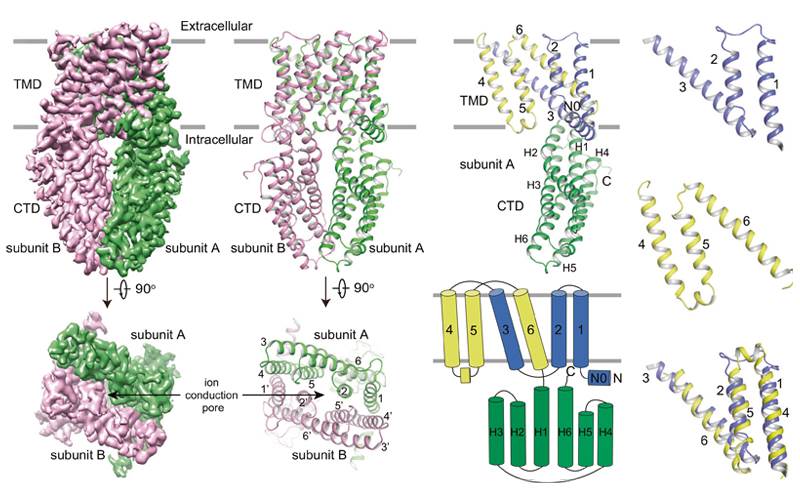Structural Research of Aluminum-Activated Malate Transporter Family (ALMTs)
Plants can overcome aluminum (Al) toxicity by secreting organic acids from their root apices. The citrate, oxalate, and malate are released into the soil to chelate Al ions, thereby preventing Al uptake into root cells. The anion channel Al-activated malate transporters (ALMT1s), such as Arabidopsis thaliana (AtALMT1), Glycine max (GmALMT1), Brassica napus (BnALMT1), and Secale cereal (ScALMT1), are Al-activated malate-permeable channels.
The Arabidopsis thaliana ALMT family contains 14 members, among which only AtALMT1 is participate in Al resistance. Recent studies have reported cryo-electron microscopy (cryo-EM) structures of AtALMT1 in the apolipoprotein, malate-bound and Al-bound states at neutral and/or acidic conditions. AtALMT1 dimers assemble an anion channel, and each subunit is consisting of six transmembrane helices (TM) and six cytoplasmic α-helices. Al binds on the extracellular side of AtALMT1 and induces conformational changes of the TM1-TM2 and the TM5-TM6, leading to the opening of the extracellular gate. These studies reveal the structure of a novel anion channel, demonstrating the structural basis for Al-activated malate transport by ALMT1.
 Figure 1. Cryo-EM structure of the ALMT1apo/pH5. (Wang J, et al., 2022)
Figure 1. Cryo-EM structure of the ALMT1apo/pH5. (Wang J, et al., 2022)
| Protein | Organism | Method | Resolution | PDB Entry ID |
| ALMT1 apo state at pH 5.0 (expressed in HEK293 cells) | Arabidopsis thaliana | Cryo-EM single particle analysis | 3.20 Å | 7VQ3 |
| ALMT1 apo state at pH 7.5 (expressed in HEK293 cells) | Arabidopsis thaliana | Cryo-EM single particle analysis | 3.20 Å | 7VQ4 |
| ALMT1 malate-bound at pH 7.5 (expressed in HEK293 cells) | Arabidopsis thaliana | Cryo-EM single particle analysis | 3.10 Å | 7VQ5 |
| ALMT1 Al-bound at pH 5.0 (expressed in HEK293 cells) | Arabidopsis thaliana | Cryo-EM single particle analysis | 3.60 Å | 7VQ7 |
| AtALMT1 Al-bound M60A mutant (expressed in HEK293 cells) | Arabidopsis thaliana | Cryo-EM single particle analysis | 3.00 Å | 7VOJ |
Table 1. Structural Research of ALMT1.
At Creative Biostructure, you can access a full range of Cryo-EM techniques, i.e., single particle analysis (SPA) and cryo-electron tomography (Cryo-ET), to accelerate your drug discovery. We can provide services for structural/functional analysis of macromolecules and subcellular complexes using cryo-EM, such as ribosomes, subcellular organelles, extracellular vesicles, nucleic acids, cytoskeleton, membrane proteins, protein complexes, and antigen-antibody complexes. If you are interested in our services, please feel free to contact us.
Reference
- Wang J, et al. Structural basis of ALMT1-mediated aluminum resistance in Arabidopsis. Cell Research. 2022, 32(1): 89-98.
